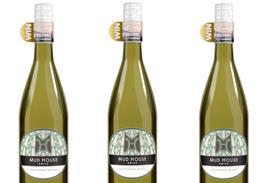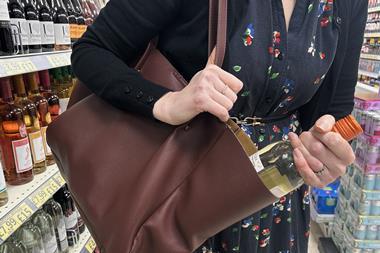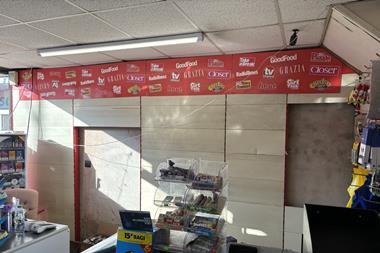Boosting shoppers’ dwell time is catching on in the convenience store industry, with features designed to encourage shoppers to spend more time - and money - in-store
There’s an electric atmosphere in the Apple Store, and it’s not just being created by the line-up of devices. Shoppers of all ages pack its bright and shiny interior as they toy with the high-tech tablets, phones and watches, in no hurry to be anywhere else. And above the sound of the chatter and laughter, the distinctive tap tap tap tap of pin numbers being entered can also be heard as shoppers splash the cash.
According to Eve Reid, from visual merchandising consultancy Metamorphosis, the Apple Store is the perfect example of a store that has mastered the art of “fun shopping rather than run shopping”. “Consumers are sick of being stuck in the mundane routine of life and are aching to see innovation; new ways of shopping and experiences that stand out,” Reid says.
What Apple, and other innovative high street retailers, including Whole Foods Market, Waterstones, and even Tesco (which has started to open gyms in some of its superstores) have learned, is that creating stores in which shoppers want to spend more time, pays.
Stores which prompt shoppers to linger can generate higher basket spend by exposing shoppers to their products for longer, while also creating an emotional connection, which in turn can boost loyalty. In short, time is money.
In fact, according to the Time Is Money study by Portsmouth research company PathIntelligence, a 1% increase in the amount of time a customer spends in-situ correlates to a 1.3% increase in sales. “It’s the quality as well as the quantity of visits that count,” the report concludes.
Excitingly, the idea of creating stores with fun, engagement and relaxation at their heart is taking hold in the convenience sector, too.
With its burger bar, Rebel Rebel florist concession and wide array of interactive features, James Brundle’s award-winning Eat 17 store in Hackney, East London, is just one example of that.
Boosting customer “dwell time” was also central to the design of independent retailer David Worsfold’s innovative new store, Farrants, in Cobham, Surrey.
The store, which has been trading since 1896, has just re-opened following an extensive rebuild which saw it double in size before being fitted with a revolutionary new layout.
The news and magazines section features two large sofas and a free-to-use coffee machine for shoppers who sign up to the store’s Friends of Farrants loyalty scheme. Customers are encouraged to sit, relax, have a coffee and browse the extensive range of magazines at their leisure, or just catch up with friends. Even the signage is designed to perpetuate this drive to “dwell”, with chunky wooden words which suggest that shoppers ‘Read’, ‘Dip’, ‘Skim’.
“Suggestion plays an important role in boosting dwell time,” David explains. “The design of this store reflects the changing way that people are shopping,” David says. “People want their shops to serve more than just one purpose; they want them to be places where they can congregate, relax and have fun as well as shop,” he said.
“Shoppers have such a range of places where they can fulfil their shopping needs these days, including the internet, so to win their custom we have to offer them more reasons to visit, and we have to do it in a fun and engaging way, which is what this store is all about,” he adds.
A double door next to the ‘kids zone’, which includes children’s toys and a striking Bertie Bassett-inspired pick and mix tower, will eventually lead out on to a decked area where local yummy mummies will soon be able to sit and enjoy a tea or coffee away from the rush of the high street.
And while best-selling cigarettes and rolling tobacco brands are housed in draws beneath the store’s attractive Mid-Western inspired wooden counter, adult smokers who would like to purchase specialist tobacco products can also enter a tobacco room behind the counter and browse the openly-displayed range at their leisure. The room also features a vast walk-in humidor and range of specialist equipment. Downstairs, in the store’s basement, a smoking room for local cigar and pipe tobacco aficionados is also opening shortly.
Recognising that building an emotional connection with shoppers is also key to boosting dwell time, fascinating local artefacts are prominently displayed around the store in a bid to engage, interest and excite shoppers. These include an ancient bicycle discovered in the store’s attic, an 1877 Pinfire Revolver dredged up by David in the local river Mole, and the engine of a Hawker Hurricane shot down over Cobham during the war.
The items, which also include a painting of David’s father who ran the business before him, are accompanied by explanatory notes which detail their history and significance. The impact on shoppers is clear to see, with the young and old alike taking their time to explore the store and its many treasures.
“Farrants has a long history of trading in Cobham, and the area itself has a fascinating past. All these little tools and artefacts help us bring our heritage and story to life. They help shoppers to identity with the business, and also to feel more connected with the area in which they live. It’s a very powerful driver of loyalty. Shoppers support businesses that they have an emotional connection with, and that’s exactly what we are developing here,” David says.
In-store signage, and particularly shelf-edge labelling, can also help build emotional connections between products and customers - buying dwell time in the reading process. Suzie Hawkins’ new Spar forecourt store in Highworth, Wiltshire, boasts examples of emotive point-of-sale signage which tells the stories of the local producers who supply much of its range.
Fun is clearly another key driver of dwell time and, as the Apple Store concept demonstrates, can be an effective way of creating an engaging space is to allow shoppers to interact with, and have fun with, the goods on sale.
The Simply Fresh symbol group is a master at this. Many of its stores feature striking wine and oil displays which allow shoppers to fill their own bottles. Creative director Davinder Jheeta explains: “Studies show that 67% of people are more likely to buy product they can experience in some way. When you can ask customers to be little more hands-on, you get them to have a more emotive experience. Touch can play a big part in increasing dwell time and importantly in boosting loyalty.
“For us, the future of the shopping environment means thinking outside the box and adding some sensory substance to complete the right shopping experience and form a more rounded, complete approach.”
Roli Ranger is another retailer whose new store has been designed with fun in mind. “Interactivity is at the heart of the store’s design,” Roli says of the new Londis Sunninghill in Berkshire.
“We aim to stop shoppers on their journey by giving them something unusual and interactive to look at and touch, such as our self-grind coffee machines, fresh orange juicer, and self-serve oils. It’s all about engaging them in the shopping experience and bringing a sense of fun to it. Shoppers are definitely making use of these interactive features and clearly enjoy doing so as sales are growing all the time,” Roli says. “People don’t tend to pop in and out of our store; they look and linger as they buy. The store feels special, different, and they enjoy spending time there.”
Interesting features such as in-store delis, kitchens or ‘beer caves’, as seen in Applegreen UK’s flagship Crawley site in West Sussex, can also promote dwell time, as can the delicious aromas created by freshly baked bread or samosas, which all add to the sensory experience.
The addition of doors on chillers and subsequent creation of warmer aisles can help, too, points out Ian Taylor, Spar UK head of retail.
And, of course, merchandising also plays a key role, as do the products themselves. Simply Fresh aims to create theatrical interiors and eye-catching product displays across its stores to stop shoppers in their tracks. Davinder Jheeta explains the rationale: “When you elevate the status of a product, it is easier to interrupt those customers shopping on auto-pilot. We do this by varying the way product is displayed. So it’s not just continuous runs of metal shelving.”
Use of different materials and textures such as wooden barrels, crates, planks and artificial privet hedging, as seen in Simply Fresh’s Downton store in Wiltshire, all add to the positive sensory experience.
“If you can create an interesting interior environment with specific areas and products you can manipulate a customers’ sense of time, and effectively you are buying dwell time,” Jheeta adds.
“Time is very important to our customers’ experiences, but equally important to us. Because, for however long they are in our stores, we want to maximise the exposure to product and add to basket spend,” he says.
The Southern Co-operative is another retailer which is devoting more of its time to developing ways to tempt shoppers to spend more of theirs in its stores.
“Use of fixture theatre to create a sense of speciality or uniqueness that complements the product offer and adds credibility is obviously a key mechanism to increase dwell time,” says Steve Tremlett, head of trading formats and implementation.
“Provision of product information, wine and food matching, for instance is a helpful way of doing this.
“In our generally small stores, The Southern Co-operative adds these specialisms with our Local Flavours ranges and provision of information at the shelf edge on the local producers and provenance of the food items on offer. Our local suppliers often participate in tastings adding interest and an opportunity to try new products,” he adds.
Clearly the creation of dwell time focused stores doesn’t happen over-night. A vast amount of planning has to be poured into the mix.
Tremlett elaborates: “You need to think carefully about how you space it out,” he says, as congestion is a big no-no. “Allowing for increased dwell time is important - and the store layout needs enough aisle width for other customers to pass, with trolleys and buggies as well.
“Our siting of chilled snacking tries explicitly to deal with this by not siting sandwiches at the front of the fresh aisle, where there is a direct clash with aisle space and dwell space also used by produce shoppers.”
In addition to wide aisles, creating an area of space at the front of the store can help to boost shopper’s inclination to dwell a little longer, Simply Fresh’s Jheeta adds.
Simply Fresh stores tend to feature what Jheeta refers to as a “transitional zone” just inside the doors. This light and spacious zone is designed to help shoppers “acclimatize” to the store, while a high-impact product display, usually made up of interesting local, seasonal or fresh goods, helps to set the tone for the rest of the shop.
Roli has employed a similar technique at his Sunninghill store. Two low-level chunky wooden display stands grace the bright and spacious area, each artfully laden with fresh local fruit and vegetables along with freshly baked local breads and cakes.
It’s fair to say they pack a striking visual punch, which is usually met with surprised “wows” by new customers. “Once in, the display tables do a great job of setting the scene for the whole store,” Roli explains. “Shoppers know this isn’t an ordinary convenience store; it’s inviting and welcoming, a place to browse, taste and touch and shop, and they love it.”
He’s not exaggerating. The 1,600sq ft store smashed it’s year-one sales target after just one month of opening back in May, proof that when you get it right, dwell time really can equal sell time.
Shop floor style
Eve Reid from visual merchanding consultancy Metamorphosis believes that a smart store should be designed “to embrace shopper’s natural movements and unconscious behaviours”. She says shoppers adhere to generic behaviours which play a significant role within space planning:
They are attracted by light, colour and reflection,
They will naturally walk towards space
They dislike opening doors; and are more likely to travel through open ones
They avoid uncomfortable spaces that restrict movement
They will also avoid other things that make them feel uncomfortable (bad smells, badly-lit areas, too brightly-lit areas, squashed spaces, too many people)
They are used to following lines on the floor and tend to naturally follow them to navigate
They drive on the left, so when they walk into a shop they tend to head left.





















No comments yet